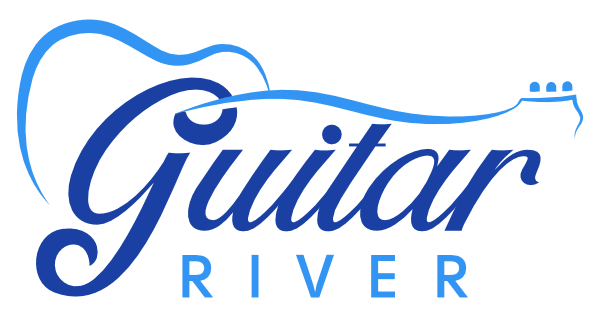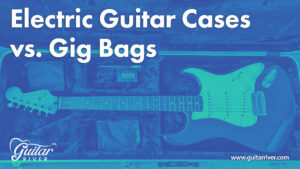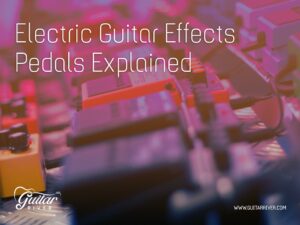Guitar River is reader-supported. We may earn a commission when you make a purchase using the links on our site.
Learn more.
Playing an Electric Guitar Without an Amp

Often, I practice my electric guitar without an amp. It’s become a habit of mine since I started playing, and I continued playing that way as I moved into apartments as an adult. I began wondering, what is the best way to practice without disturbing the peace, and how common is it for guitar players to play without an amplifier.
So can you play your electric guitar without an amp? And why would you want to play this way? The short answer is yes, of course you can play your electric guitar without an amplifier. This may not be the way you play most of the time, but it’s not a bad way to practice. Some guitarists have even ditched their amps for amp simulators and multi-effects pedals when performing on stage.
You might bypass the amp to record directly to a digital audio workstation (DAW). There are some techniques to consider, and also some caveats so you don’t develop bad habits playing without an amp.
First, we’ll take a look at why you might want to play without an amp and how you can do it effectively. We’ll also cover what not to do, and things to keep in mind when you plug back in to your amp. And we’ll look at some ways to connect directly to your computer and recording software.
So, why would you want to play your electric guitar without an amplifier?
Practice
There are a few reasons you might want to do this. I usually practice at night, and playing unplugged or through headphones doesn’t disturb anybody. Living in an apartment can make practicing without an amplifier a good option. If you are not using your amp, you won’t be bothering your neighbors. No one will hear your electric guitar unplugged or through headphones, at least not your solid-body electric.
You’ll also get a good feel for the guitar itself. My main guitar actually has a great sound unplugged. It sounds fantastic plugged in too, but I can hear the tonal characteristics of the instrument itself without the amp. I know it’s going to sound good when I plug it back into my amp.
Practicing without an amp, you’ll be able to focus on your technique as well. If you normally play with distortion, that can sometimes cover up sloppy technique. You can hear more easily when you miss a note, or if your picking hand and fretting hand are coordinated.
Recording
To record your guitar playing, you have a couple of options for home recording. You can mic up your amp and send the signal to a digital audio interface, or you can plug directly into the interface. You’ll need some different hardware and software to do this, but it’s a good way to work.
Unless you are a professional, it can be difficult to figure out the best way to record your amp with a microphone. Hardware and software have come a long way, and it’s now very easy to record your guitar signal directly to your computer or tablet. We’ll take a look at some ways to do that below.
Performing Live
You might be bypassing speaker cabinets on stage and going directly to the venue’s PA system. Check out this video of Nita Strauss using her multi-effects pedal and skipping the amp altogether. This can be a great way to cut down on the amount of gear you need to haul around to shows.
You can also opt to go wireless. Skip the cords altogether and use a wireless transmitter to connect to the sound system. For about $150, you can get a wireless transmitter and receiver to make playing on stage that much easier.
What are the best ways to play without an amp?
Headphone Amp
One of the easiest ways to play without your amp is to use a headphone amp. These small devices plug directly into your guitar, and send the signal to your headphones. You’ll even get some built-in effects. It’s a great way to practice with headphones.
Check out the Blackstar amPlug 2 FLY. For about $50, you’ll have clean, crunch, and lead tones for practicing without an amp. Chorus, delay, and reverb are included.
The Fender Mustang Micro headphone amp is perfect for practice, and generates some sweet tones for about $100. The amp modeling from the Mustang amp series is packaged in a small headphone amp. It may be all that you need for your practice sessions.
On the higher-end of the price spectrum, the Boss WAZA-AIR will simulate the sound of your amp in different rooms and environments, and give you a range of effects and premium sound.
Mobile Device or Tablet
With a smartphone or tablet, you have access to amp simulator software such as BIAS FX and Amplitube. Both software packages have mobile and desktop versions. I enjoy both. I find BIAS FX has a lot of fun, pre-programmed amp and effect chains that are fun to play with. Their new Jimi Hendrix add-on is worth it!
In order to connect to your phone or tablet, you need a compatible interface. I use the iRig HD 2. It’s very easy to use, costs about $100, and comes with a limited version of Amplitube. I can get extremely realistic amp simulations on my iPad with Amplitube and a pair of headphones.
Multi-Effects Pedals
Multi-effects pedals for guitars have been around for a long time for good reason. You can get a wide variety of tones in one compact package. These are relatively inexpensive, and can be a good way to get different amp simulations and effects. Some such as the Line 6 POD Go will act as an audio interface as well with USB out.
Amp Modeling
This is perhaps what most people think of when considering alternatives to a guitar amp. Amp modelers are professional units that can replace your amp for recording or playing live. They come in different form factors, tailored to the studio or a concert stage.
As a solution for professional musicians, amp modelers come with a hefty price tag. However, since they can replace a storage unit full of amplifiers, and provide an expansive range of tones, the price will be worth it to some guitar players.
Some of the well-known amp modelers out there include the Line 6 Helix, Neural DSP Quad Cortex, Fractal Audio Axe FX, and the Kemper Profiler.
Computer Recording
You can also send the guitar signal to your computer using a recording interface. There are a lot on the market, but for about $100 you can get a basic USB audio interface such as the Focusrite Scarlett, or the PreSonus AudioBox USB 96. Some amps, such as the Blackstar ID:Core 10, can act as a recording interface so you don’t have to buy anything extra.
Once you have your guitar connected to your computer, you can then listen to your guitar with studio monitor speakers, computer speakers, or your headphones. You can bypass your guitar amp this way. Be aware that you may experience a slight bit of latency on the signal.
You will need DAW software to record your guitar. This can be as simple as Garage Band on the Mac. I like PreSonus Studio One. There is a free version to try out and get started.
Unplugged
If you are practicing and don’t want to disturb anybody, you can just play unplugged. This is not bad for playing scales for a few minutes, but it gets boring pretty quickly. If you already have a practice amp, it will likely have a headphone out jack. You can plug your headphones in directly and spare those around you from your practice session.
Old Stereo Equipment
Lastly, you may have some old stereo equipment lying around. There will be an audio input somewhere on the amplifier. In a pinch, you can experiment plugging in directly. You may need a ¼” adapter for your guitar cable. Even better, you can plug your multi-effects pedal into the line-in and achieve some decent sounds.
I had an old Sony boombox with a CD and dual cassette players sometime in the 90s. (It was state of the art back then.) I plugged my guitar directly into it, and used it as an inexpensive multi-track recorder. It was a fun way to quickly record ideas.
What are the downsides of playing without an amp?
So now that we know why you might want to play without an amp, what are some reasons why you might want to remain plugged in to your amplifier?
Playing Technique
When playing electric guitar with headphones, you may inadvertently develop a different playing technique by changing your attack. You may have a tendency to pick the strings harder to create more sound. Or, you might develop a very light touch from practicing softly.
The next time you plug your guitar back in to an amplifier, you might find yourself backing off your approach to tone down the sound. Or you might find yourself playing with all the subtlety of a freight train.
The main takeaway is to also spend time playing plugged in to your regular amp if you are going to be practicing electric guitar with headphones and amp simulators.
Limitations of the Hardware or Software
When recording by plugging your guitar directly into a DAW, you’ll be limited by the sounds available. This may sound odd in that there are a ton of digital effects and different sounds you can use to affect your original guitar signal. But if you want to recreate the sound of your amp, you may be better off recording your amp with a microphone.
You might prefer the sound of your amp, especially if you have a good one. This will depend on the genre of music as well. If you are a blues or jazz player, you’ll likely want to mic up an amp and send that to your DAW instead of going digital right from the start. You’ll record the sound of the amp and the natural acoustics of the room. There is a reason why professional recording studios exist.
I have a Blackstar ID:Core 10 that I use as a practice amp. I also have a 90 watt Fender Princeton Chorus from the late 90s or early 2000s. There’s no question that the Fender amp has a richer sound. But I’m also comparing a large 90 watt amp with a small 10 watt practice amp, so it’s not exactly a fair comparison.
Anyway, the Blackstar has the added benefit of acting as a digital interface. I can plug it directly into my Mac via USB and record with GarageBand. This works well, but I’m limited to some extent by the original sound of the Blackstar amp.
It has two clean channels, two crunch channels, and two overdrive channels. I can record one of the clean channels and then apply effects to it within the DAW, but I’m also relying on the sound of that original clean channel.
It really depends on how you record your guitar signal, and what interface you are using to record. If you want to recreate the sound of your tube amp on a recording, you may be better off micing up the amp and recording that instead of using digital effects or amp modeling.
So in conclusion, yes, you can play your electric guitar without an amplifier. Hopefully we have clarified when you may want to do this, and the best way to go about it.



